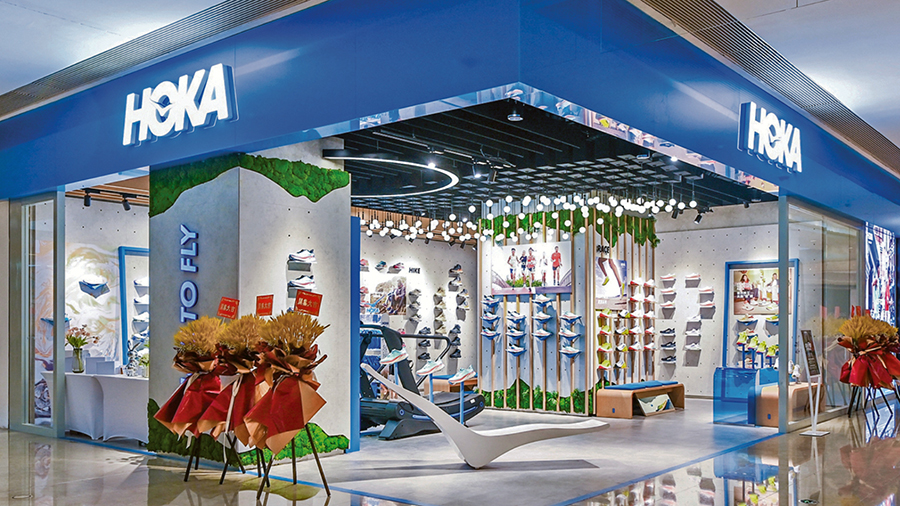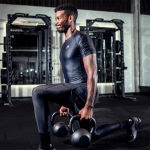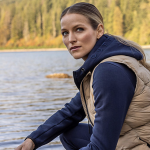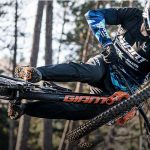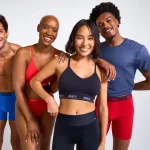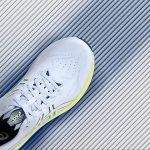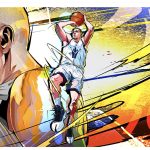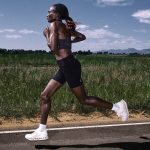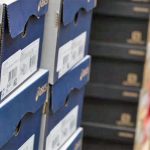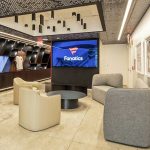In another example that a company is only as good as its last quarter, the parent of Hoka, Ugg, Teva, Ahnu, and Koolaburra found that all the great numbers and marketing hype from the fiscal 2025 full-year period did little to instill confidence in investors. On Thursday, May 22, during the afternoon’s fiscal fourth conference call with investors and analysts, Deckers Brands CEO Stefano Caroti seemed less engaged in the fiscal fourth quarter results or the guidance, or lack thereof, for the year ahead. Instead, CFO Steve Fasching took the lead on the apparent issues surrounding the weakness of the fourth quarter, particularly the sales trend at the Hoka brand that had weakened over the last year and missed consensus estimates by three percentage points in the fiscal fourth quarter.
DECK opened down more than 23 percent on Friday, May 23 after the company pulled full-year guidance – citing President Trump’s tariffs – which has been an easy way for companies to avoid forecasting the year ahead and placing a marker down in a market filled with uncertainty. But the company seemed oblivious to the fact that the Trump Administration removed some of that uncertainty two weeks ago after working out a deal with China on a 90-day pause on tariff tit-for-tats, lowering China tariffs to 30 percent and all other countries assessed at 10 percent as the new baseline rate.
It’s hard to believe that the company would expect analysts to miss the fact that Deckers claimed China tariff uncertainty prevented the company from providing forward guidance when revealing on the same call that only 5 percent of their foreign-sourced production was coming from China and primarily going to other non-U.S. markets. According to management commentary on the call, the vast majority of product shipments were coming out of Vietnam. So why not model for that 10 percent as other companies have?
Look at the outcome from the Amer Sports 2025 Q1 earnings release and conference call on May 20 to understand what a fully engaged CEO can do to build confidence in uncertain times by using the newly reduced tariff levels as a baseline to present forward guidance with the caveat of “if tariffs stay where they are” as a qualifier – despite slowing Q1 growth at Arc’teryx, the company’s fastest growing brand. Sound familiar?
“But numbers such as these do not give Amer Sports CEO James Zheng pause. He’s just getting started,” SGB Executive wrote in its analysis of the Amer Sports quarter and outlook.
Analysts get that plan. Investors can plan against it. Quant models can be built with that information. Amer shares jumped 19 percent that day, closing at $37.37 per share, just shy of triple the IPO price from January 29 last year.
But instead, Deckers decided to punt. They will go silent on guidance for now, only providing a view of what they were thinking before the April 2 tariffs hit.
It was not well received:
- Telsey Advisory Group downgraded DECK shares to Market Perform from Outperform and slashed its price target (PT) in half from $240 to $120.
TAG said the company had a “strong fourth quarter” with solid revenue growth and gross margin expansion, but the firm cited “the deceleration of the Hoka and DTC businesses, margin pressures from channel mix shifts towards wholesale,” and tariff-related cost headwinds.
- Williams Trading said it was lowering estimates and cut the PT from $140 to $129. The firm said in an investor note that the first quarter guidance “fell short of expectations, as the outlook for Hoka sales, gross margin, and EPS were below consensus expectations.” The outlook for Ugg was said to be in line with consensus.
Still, WT analyst Sam Poser said, “We recognize that many investors are transfixed by Hoka’s U.S. DTC sales, which were down in 4Q25, but all of our checks with Hoka’s retail partners are calling out very strong sell through rates.”
“We expect the DECK’s cautious outlook will once again prove unfounded as consumer demand for Hoka and Ugg remains strong,” the veteran footwear analyst wrote.
- KeyBanc downgraded Deckers to Sector Weight, pointing to “Hoka’s slowing trajectory, shift toward wholesale door growth, and potential demand erosion from price increases.”
The firm added that while Deckers has executed well, “Hoka no longer feels as competitively positioned vs. other disruptive running brands that continue to outperform.”
- Stifel Financial maintained its HOLD rating on Deckers shares and its PT at $127. The firm said that fiscal Q4 featured upside in Ugg revenue which came in $60 million above Stifel estimates, gross margin that was 370 bps above Stifel, and upside in expense control and a favorable tax rate.
“Hoka, however, missed consensus revenue estimates – $23 million miss – for the first time since December 2021 when the market saw COVID-19 influenced supply disruption.
Stifel continued, noting that, “Hoka has a credible pathway forward for growth …. but DTC deceleration … raises questions about brand momentum.”
- Evercore ISI downgraded DECK shares to to “In-Line,” warning that “the high growth story is behind us” and cut its PT to $110 from $235. The firm said it believes Deckers is entering “a new phase of lower growth” as Ugg and Hoka show signs of deceleration.
Analysts across the board pointed to Hoka’s slower customer acquisition in the U.S., increased promotions, and limited near-term catalysts as key concerns, according to reporting from Investing.com.
CEO Stefano Caroti was charged with recapping the full year for Deckers and its two key growth brands.
“Our team’s focus on the long term has proven to be a winning strategy, driving incredible progress over the past five years, including total company revenue growing at a compounded annual rate of 19 percent, Hoka adding approximately $1.9 billion of revenue, Ugg adding $1 billion of revenue, gross margin expanding 600 basis points, operating margins increasing 750 basis points and delivering an EPS compound annual growth rate of 32 percent. These results demonstrate the strong foundation we’ve built and provide a powerful framework in which we continue to operate,” Caroti said in his prepared remarks.
Caroti also shared that the company’s fiscal 2025 full-year record performance included revenue growth of 16 percent versus the prior year to bring the company to just shy of $5 billion in revenues, gross margin expansion of 230 basis points year-over-year to 57.9 percent of sales, operating margins improvement of 200 basis points year-over-year to 23.6 percent of sales, and earnings per share of $6.33, up 30 percent year-over-year. All good stuff. But that good year is behind us.
“In the nearly four months since our last earnings call, there’s been a significant amount of uncertainty introduced as a result of shifting U.S. trade policy,” Caroti offered as a baseline for the conversation. “While we expect impacts to our business in fiscal 2026, we do believe that our company and brands are highly capable of responding to challenges with the ability to adapt to consumer and marketplace shifts as needed.”
Caroti said the company’s disciplined approach has yielded two industry-leading brands, Ugg and Hoka, each with distinct products that operate in differentiated marketplaces, giving us multiple levers to adjust in this period of uncertainty.
CFO Steve Fasching echoed the CEO’s commentary, highlighting Deckers’ “exceptional performance“ in fiscal 2025 as the company delivered its fifth consecutive year of double-digit revenue and earnings per share growth.
Fasching added that net sales increased 6.5 percent to $1.02 billion in the fiscal fourth quarter ended March 31, 2025, compared to $959.8 million in the prior-year Q4 period. On a constant-currency (cc) basis, net sales increased 7.5 percent year-over-year (y/y).
“Looking ahead, while the macroeconomic environment remains fluid, and there is greater uncertainty around consumer spending, we remain committed to our fundamentals,“ the CFO said. “Deckers’ flexible operating model and disciplined approach to financial management allow us to be nimble and navigate the current economic environment with confidence.“
Fasching noted that the company exited fiscal 2025 in “a position of outstanding financial strength.“
Hoka Brand
Hoka brand net sales increased 10.0 percent to $586.1 million in Q4, compared to $533.0 million in the prior-year Q4 period. The quarterly sales trend, while double-digit positive, was clearly the weakest in over a year. The year-ago fourth quarter saw Hoka up 34.0 percent y/y, outpacing full-year growth. For the fiscal 2025 first quarter, Hoka sales jumped 29.7 percent but growth weakened slightly before increasing 34.7 percent y/y in fiscal Q2. For the fiscal 2025 third quarter, Hoka grew 23.7 percent in the holiday quarter ended December 31, 2024.
“Hoka continues to gain market share [with] performance runners while also continuing to expand its addressable market by building global awareness and attracting consumers who want to wear more technical and comfortable footwear for a variety of use cases,“ Fasching noted.
“For Hoka, global Wholesale was the primary driver of growth in the fourth quarter, as the brand benefited from expanded distribution in sell-in of the Bondi 9 that launched mid-January and experienced strong sell-through in the channel throughout the quarter, as many consumers sought out new products in store.“
From a DTC standpoint, Fasching said the Hoka brand drove a 3 percent increase versus the prior-year Q4 period, which he said reflected “continued strong growth from international regions and a slight decline in the U.S. due to some unique factors in the quarter.”
Those factors in the U.S. market included “consumers opting to explore and purchase new product updates in store, higher levels of promotion on outgoing models and slower new consumer acquisition in the face of macroeconomic uncertainty.”
The “macroeconomic uncertainty” reason has become a script favorite for CEOs and CFOs this year describing the slow-down in consumer engagement. However, recent surveys and data from the National Retail Federation (NRF) and the U.S. Department of Labor found healthy economic retail activity from the consumer. If anything, consumers appear to be buying down, but they are buying, which could clearly hurt a premium brand like Hoka, and the jury is out on whether this is a near-term trend or it is here to stay. The April data continued to show that e-commerce channels are outpacing the rest of the market.
“While in the near-term, this has put pressure on the Hoka brand’s DTC growth, we are encouraged by the online retention metrics from repeat consumers in both the U.S. and internationally, and expect this trend to improve following the first fiscal quarter,“ Fasching noted.
For comparison, the other athletic footwear darling that is supposed to be putting pressure on Nike, On Holding, boasted first-quarter sales growth of 40 percent y/y on a constant-currency basis on top of 29.2 percent growth in Q1 last year. DTC jumped 42.4 percent y/y for the period ended March 31, while Wholesale grew 38.6 percent y/y in the quarter. The Americas business was up 28.6 y/y in constant-currency terms.
On also raised its 2025 full-year guidance. Granted, Hoka has a more mature business in the space, but the On brand is definitely taking more share now.
In recapping the full-year business, CEO Caroti shared that Hoka’s global revenue in fiscal 2025 increased 24 percent y/y to $2.2 billion. Hoka’s revenue growth versus last year was reported to be robust across channels and regions, with Wholesale revenue growing 24 percent, outpacing door growth, which Caroti said indicated share gains with existing doors as it increases brand presence. DTC revenue increased 23 percent for the year, driven by “continued global gains in consumer acquisition and retention.“
Hoka’s International revenue expanded 39 percent and represented 34 percent of global revenue, up from 30 percent in fiscal 2024. Domestic U.S. revenue increased 17 percent y/y, totaling just under $1.5 billion for the year.
“The Hoka brand success across channels and regions continues to benefit from efforts to build brand awareness around the world,“ the CEO suggested. “According to our most recent proprietary brand awareness survey, consumer awareness of Hoka in the U.S. has now reached 50 percent, which is a 25 percent increase from the same point in time last year.”
Caroti added that across international markets, awareness has increased to an average of approximately 30 percent, up from roughly 20 percent at this point last year.
“This represents meaningful progress in our continued journey to build Hoka into a leading global performance brand, achieved primarily through deepening our global investments in brand-building initiatives, adding points of distribution across key markets and, most importantly, drive innovation with product newness and technology upgrades,“ Caroti said.
Caroti added that opening new Hoka retail stores in influential locations, like the new flagship store in Shanghai he recently visited, contributes to this progress and demonstrates the company’s commitment to brand-building efforts. More owned-retail Hoka brick & mortar appears to be a priority.
“We’re still in the early stages of building out the Hoka brand’s physical DTC presence; this Experience Center [in Shanghai] gives us a concept of engaging elements to deploy in future locations over time,“ Caroti shared.
“At the same time, we continue to leverage our valued Wholesale partners to further expand the Hoka brand’s in-store presence,“ he noted. “As you view the progress in awareness, both in the U.S. and internationally, as inflection points that indicate a growing appetite for a wider Hoka distribution.”
After walking through product launches over the last year, Caroti tipped his hat to the latest releases for the brand’s two big franchises — the Bondi and the Clifton — with Bondi 9 having a strong January launch and the Clifton 10 hitting in April.
Looking ahead, Caroti said the global addressable market for Hoka continues to expand as more consumers adopt active lifestyles. “We like to say that we are in the early miles of a long-distance run for the powerful performance brand, with our global markets in different stages of the journey,“ he continued.
In the U.S., Caroti talked about the playbook the company is using that built Hoka into a top-performing brand in specialty distribution. Drive acquisition in the brand’s DTC channel as consumers can engage with the full breadth of the product assortment and increase opportunities for new consumers to discover and experience Hoka to select Wholesale expansion as brand awareness grows.
“We continue to see substantial U.S. mature opportunities ahead through control distribution increases, expanded categories, replenishment and further consumer acquisition in the DTC channel,“ Caroti noted.
He said Hoka is still emerging across international markets, with the company’s view that EMEA and China are the brand’s two largest direct percentage growth drivers in the near term, aided by contributions in other markets.
“In EMEA, Hoka is moving up brand rankings with our specialty partners in the U.K., Germany, France, and Italy,“ the CEO detailed. “It’s one of the fast-growing athletic footwear brands with key influential supporting good retailers and is expanding its presence with key lifestyle athletic partners as the brand gains recognition with the consumer.”
In China, Caroti said Hoka is increasing its partner footprint in key cities with strong local operators, resonating as a premium performance brand online with a high degree of full-price selling, gaining share in major road races in the region and altogether building strong community engagement through local investments, partnerships and athlete sponsorships.
“Through the strength of these markets, we expect to drive higher proportional international growth in relation to the U.S. as we aim for regional parity, but realize this will take time as Hoka continues to expand in America,“ he said.
“Lifestyle and fitness are still in their global infancy for Hoka, and we believe the brand can begin to establish meaningful market share in the years to come,“ Caroti said.
Ugg Brand
Ugg brand net sales increased 3.6 percent to $374.3 million in Q4, compared to $361.3 million in the prior-year Q4 period. The trend here was also disappointing versus the fiscal 2024 Q4 trend when net sales increased 14.9 percent y/y.
“Ugg continues to build share across genders, generations and geographies, inspiring brand love and consumer adoption for a variety of unique product franchises that span across seasons,“ Fasching commented.
Wholesale was also said to be Ugg’s primary driver of global growth in the fourth quarter as the channel benefited from selling transitional styles like the low male sneaker and spring season sandals from the Golden collection.
Ugg DTC was reportedly down 3 percent versus the prior-year Q4 period, which is said to be primarily due to the limited availability of key styles during the quarter this year due to strong sell-through earlier in the year. The fiscal 2024 fourth quarter benefited from 2024 third quarter back order fulfillment.
Caroti shared that Ugg’s global revenue increased 13 percent y/y to $2.5 billion in fiscal 2025. The Ugg brand reportedly drove strong growth versus last year across channels and regions with Wholesale revenue increasing 15 percent, reflecting an elevated presence with key influential retailers that are enhancing the brand’s global exposure.
Ugg DTC revenue rose 11 percent for the year, driven by continuable gains in consumer acquisitions and retention.
Ugg International revenue expanded 20 percent y/y, and represented 39 percent of global sales in fiscal 2025, up from 37 percent in he prior year. U.S. revenue grew 9 percent for the year to just over $1.5 billion.
Fasching said both of the company’s top brands are succeeding by putting the consumer first, driving strong loyalty through compelling and continuous product innovation that maintains their distinct respective brand codes.
Other Brands
Other brands’ net sales, which include Teva, Ahnu and Koolaburra, decreased 6.3 percent to $61.3 million Q4, compared to $65.5 million in the prior-year Q4 period.
During the fourth quarter of fiscal year 2025, the company updated its reportable operating segments to better reflect changes in the way management evaluates performance, makes operating decisions, and allocates resources.
As of March 31, 2025, the company’s three reportable operating segments now include the worldwide operations of the Ugg brand, Hoka brand, and Other brands, primarily comprised of the Teva brand, Ahnu brand, and Koolaburra brand. Before this change, the company’s six reportable operating segments included the worldwide wholesale operations of the Ugg brand, Hoka brand, Teva brand, Sanuk brand, Other brands, and DTC.
Fourth Quarter Channel Summary
Wholesale net sales increased 12.3 percent to $611.6 million compared to $544.6 million in the fourth quarter. Direct-to-consumer (DTC) net sales decreased 1.2 percent to $410.2 million compared to $415.2 million. DTC’s comparable net sales decreased 1.6 percent.
Fourth Quarter Region Summary
Domestic U.S. net sales amounted to $647.7 million in the fourth quarter, flat to the prior-year comparative quarter. International net sales increased 19.9 percent to $374.1 million compared to $312.0 million.
Fourth Quarter Profitability & Expenses
- Fourth quarter gross margin was 56.7 percent compared to 56.2 percent.
- SG&A expenses were $405.8 million compared to $395.2 million.
- Operating income was $173.9 million compared to $144.3 million.
- Diluted earnings per share was $1.00 compared to 82 cents per diluted share in the the prior-year Q4 period.
Outlook, Tariffs & Price Hikes
Given the macroeconomic uncertainty related to evolving global trade policies, the company said it will not be providing full-year guidance for fiscal year 2026 at this time.
“Prior to the introduction of tariff uncertainty, aligned with our longer-term aspirations, we were targeting our brands to deliver another year of double-digit growth, led by mid-teens growth from Hoka and mid-single-digit growth from Ugg,“ Fasching noted. “Based on the tariffs, as of today’s date, which are still subject to change, we expect to face an increase of up to $150 million to our cost of goods sold in fiscal year 2026, with the related yet-to-be-determined impact to demand.”
While the company does not intend to provide quarterly guidance on a regular basis, the following represents management’s current outlook for the first 20026 fiscal quarter:
- Net sales are expected to be in the range of $890 million to $910 million, below the ~$925 million analysts’ estimate.
- Diluted earnings per share is expected to be in the range of 62 cents to 67 cents per share, a big miss from the 79 cents per share expected by Wall Street.
- Diluted earnings per share guidance excludes any impact from additional share repurchases.
The company said its outlook is forward-looking, reflecting its expectations as of May 22, 2025, and is subject to significant risks and uncertainties that limit its ability to accurately forecast results.
From a sourcing perspective, the CFO said less than 5 percent of the company’s footwear production comes from China, some of which would not be routed for sale into the U.S. He shared that the remainder of production comes from Southeast Asian countries, primarily Vietnam.
“Our teams are closely monitoring changes to tariff policies and continue to evaluate levers to mitigate the impact on our business, including, but not limited to, flexing the pricing power of our brands, which we are assessing for strategic, selective and staggered implementation in the U.S. market and negotiating cost sharing with our factory partners,“ Fasching stated. “Although even with these mitigation efforts, we expect to absorb a portion of the tariff impact as we do not anticipate that these actions will fully offset incremental costs in fiscal year 2026.”
Fasching said the company also believes there is potential to see demand erosion associated with the combination of price increases and general softness in the consumer spending environment.
Consistent with long-term objectives, Deckers Brands expects Hoka to continue as its fastest-growing brand. Ugg to grow as it builds on top of impressive recent momentum, international growth to outpace the U.S. and Wholesale likely to outpace DTC, particularly for Hoka.
“We have a healthy order book across both brands that have not experienced material changes year-to-date,“ the CFO shared. Still, he noted that they have yet to see the full impact of the tariff implementation.
“We have existing and new partners who want to support the Hoka brand with incremental doors,“ he offered. “We will continue to be selective about where and how many additional doors are open, but believe this is a great opportunity for Hoka to acquire new consumers through brand discovery at wholesale.”
Fasching said Ugg continues to bolster its position as a leading premium lifestyle brand and there continues to be more demand from Wholesale than the company has been willing to fulfill.
“From a gross margin perspective, we are facing a number of headwinds that include increased tariffs, higher levels of promotion relative to the exceptionally low levels experienced over the last couple of years, unfavorable impacts from more expensive upgraded materials absorbed into our margins and higher ocean freight rates in the first half,“ the CFO continued. “We believe these headwinds can be fractionally offset by selective and staggered price increases in the U.S. and partial cost sharing with factory partners. Overall, this is expected to result in a decline in our gross margin relative to the record high of 57.9 percent achieved in fiscal year 2025.“
On the SG&A front, the company plans to largely keep planned investments intact as the strength of its operating model continues to fuel the future of its brands.
“We will continue to tightly manage our expenses and drive efficiencies, but at the same time, provided the ability to grow brand awareness and share, we will look to invest in our brands,“ Fasching said. “This could result in a short-term increase in our SG&A expense ratio to revenue. But we believe over the longer term, better positions our brands in the global marketplace.“
The CFO said the company views the current environment as an opportunity to flex its best-in-class operating model and free cash flow generation.
“While we expect to continue investments that support strategic areas of growth, we are actively engaged to drive efficiencies in other areas of the business that can help offset some of these incremental investments,“ he explained. “Our ability to continue investing in alignment with our long-term strategy is something we see as a competitive advantage. With a normalized consumer environment, we believe we can deliver leverage in the coming years.”
Similar to how the company is looking at SG&A, DECK expects to deploy focused capital expenditures in the range of $120 million to $130 million to support the future of the company.
Change in Board Leadership
Deckers Brands has named Cindy Davis as chair of the Board of Directors, effective immediately. She succeeds Mike Devine, III, retiring from the Board after over 14 years of service, including six years as chair.
Davis joined the Deckers Brands Board in 2018 and has served as chair of its Talent & Compensation Committee since 2019 and as a member of its Corporate Responsibility, Sustainability & Governance Committee since 2021. She reportedly brings significant footwear and retail industry leadership experience, having served in several public company executive and board roles throughout the last three decades. Davis’ particular expertise was said to be in the areas of premium branding, finance, and risk oversight, has been instrumental to Deckers, which has achieved record growth during her tenure.
“We are delighted to name Cindy as the next chair of the Board,“ offered Devine. “Over the past seven years, Cindy has added tremendous value, leveraging her deep consumer retail and brand development capabilities. As Deckers’ iconic brands continue to gain strong momentum on a global scale, Cindy’s knowledge and oversight will support the company’s continued success. I am proud of the track record of growth and innovation we have established and believe Deckers is well positioned to deliver value for stockholders and provide elevated experiences for customers for years to come.”
Davis commented, “I’m honored to be appointed as chair of the Board. Deckers has become an industry leader, offering unique and purposeful products that are increasingly embraced by consumers worldwide. The strength of our brands, disciplined marketplace management and long-term vision have positioned us for continued growth and top-tier levels of profitability. I look forward to working closely with the Board and management team to create value for all Decker’s stakeholders. On behalf of the Board, I also want to thank Mike for his unwavering dedication to Deckers and remarkable leadership during a period of immense evolution for the company, marked by five consecutive years of double-digit revenue and earnings per share growth.”
In connection with Davis’ appointment as chair of the Board, Victor Luis, who has served as a member of the Board and as a member of the Talent & Compensation Committee since 2020, has been named chair of the Talent & Compensation Committee.
Effective immediately upon Devine’s retirement, the Board approved a reduction in its size from 11 to 10 members.
Image courtesy Hoka Shanghai / Deckers Brands Group

